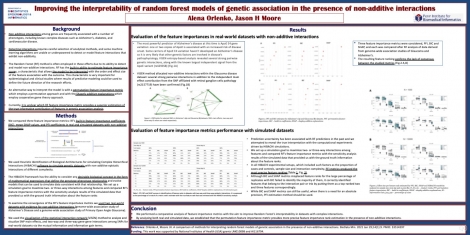Alena Orlenko
Improving the interpretability of random forest models of genetic association in the presence of non-additive interactions
Abstract
Non-additive interactions among genes are frequently associated with a number of phenotypes, including known complex diseases such as Alzheimer’s, diabetes, and cardiovascular disease. Detecting interactions requires careful selection of analytical methods, and some machine learning algorithms are unable or underpowered to detect or model feature interactions that exhibit non-additivity. The Random Forest (RF) method is often employed in these efforts due to its ability to detect and model non-additive interactions. RF has the built-in ability to estimate feature importance scores, a characteristic that allows the model to be interpreted with the order and effect size of the feature association with the outcome. This characteristic is very important for epidemiological and clinical studies where results of predictive modeling could be used to define the future direction of the research efforts. An alternative way to interpret the model is with a permutation feature importance metric which employs a permutation approach and with the Shapely additive explanations which employ cooperative game theory approach. Currently, it is unclear which RF feature importance metric provides a superior estimation of the true informative contribution of features in genetic association analysis.
To address this issue, and to improve interpretability of RF predictions, we compared different methods for feature importance estimation in real and simulated datasets with non-additive interactions. As a result, we detected a discrepancy between the metrics for the real-world datasets and further established that the permutation feature importance metric provides more precise feature importance rank estimation for the simulated datasets with non-additive interactions.
Keywords
Machine learning, feature importances, random forest, epistasis, simulation, Alzheimer’s disease, glaucoma.Commenting is now closed.
About Us
To understand health and disease today, we need new thinking and novel science —the kind we create when multiple disciplines work together from the ground up. That is why this department has put forward a bold vision in population-health science: a single academic home for biostatistics, epidemiology and informatics.
© 2023 Trustees of the University of Pennsylvania. All rights reserved.. | Disclaimer



